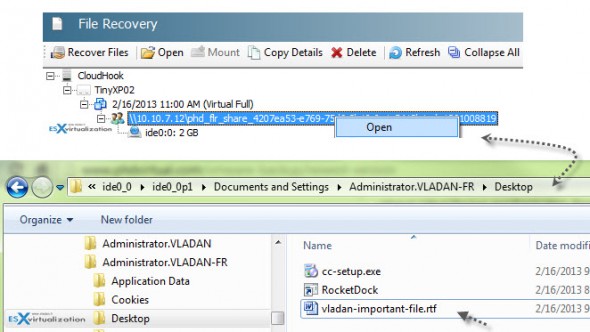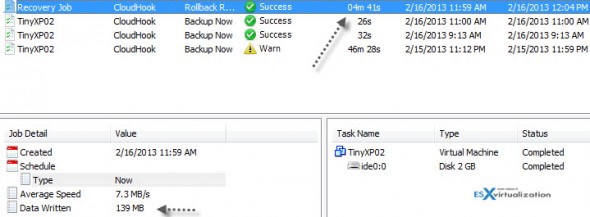PHD Virtual CloudHook – The Restore Test
The first test was the file restore test. While this might be fairly common options on backup software, only a few years back we were using command line tools in vSphere Data Recovery! The file level restore (FLR) works out of the box and you have the ability to mount the VM's files as a network share or network location.
To initiate the FLR you must go to the Backup Catalog > and Right Click the VM from where you want the file to be restored. In my case I had a file on the desktop, to be recovered. Not much to my surprise, the recovery process was fast and it worked well.
Full VM restore test – Now I wanted to test the Rollback recovery. So I went and deleted some system files in my VM, to make the VM unbootable. I initiated a restore operation.

The assistant provides you with three different options; one of them is rollback recovery. The data will be written over the existing VM where only the changes are pulled down from the cloud storage.

As a result, you can see the time for the recovery and how the data has been written. This is certainly very good result, but please, bear in mind that you must take the download/upload speed in your environment into consideration when working with much larger production VMs. This can often give you a rough idea on how the software can perform.
Security and encryption
The product provides encryption possibilities which are important for anyone sending data to an off-site cloud provider. The data is encrypted before leaving the PHD Virtual backup appliance, using government grade encryption mechanisms. The user is the only one that knows the key and needs to make sure they don't lose it. If you ever replace the VBA connected to the cloud, you will need to give that new VBA the key so it can mount the encrypted cloud backups.
Wrap Up
With every release, PHD Virtual adds new features to provide good value for customers. Today, IT admins are facing the dilemma between having fast RTO together with offsite backups. Usually, a tape or external USB drives were used as low-cost solutions. But the manual process of handling tapes, or USB drives to offsite locations was suboptimal and made the process painful.
With the new version 6.2 of PHD Virtual Backup, PHD Virtual is delivering a powerful product that makes it easy to take advantage of affordable automated cloud storage as an offsite backup location. With CloudHook, PHD Virtual is providing a great way for SMBs to become less vulnerable to accidents, disasters and failures.
Replication capabilities can be used for clients with remote offices, but this feature together with instant recovery and PHD Motion capabilities was already reviewed in my previous article covering the 6.0 release.
PHD virtual fast deployment and performance along with no necessity to purchase additional hardware for server backup is proof that PHD Virtual Backup has evolved to continue providing high level of value for VMware or Citrix administrators.
You can find out more about PHD Virtual Backup or sign up for a Free Trial at PHD Virtual.
Note: This review was sponsored by PHD Virtual Technologies.


